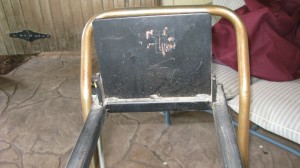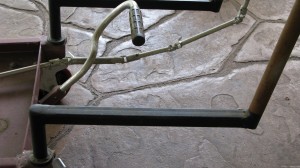Transportation of 1.5” Scale Equipment – Some Options
Upon initiation into 1.5” scale, it did not take long to realize many things changed from experiences in the HO hobby. I learned from others and made some mistakes. Hopefully this review of several items will help others.
My first effort to own 1.5” scale equipment was the purchase of a cabin car (caboose). Rick White hauled it home from Michigan, and I soon realized that I needed some sort of cart to put it on.
I received many inputs. Some built of wood to match one vehicle, some built of steel, some with chain drives for elevation control. I did not find anyone that had the flexibility I felt I would need in the future.
One day I was shopping at Northern Tool & Equipment and noticed a “sale” sign on a group of “Hydraulic Tables”. There were 5 different types. Options included different capacities, different height ranges, different minimum heights, different maximum heights, and different table sizes. Prices ranged from $200 to $500. I considered this to be a livable cost given the cost of a single car kit. I picked two tables.
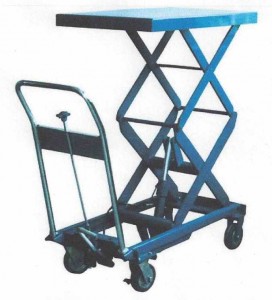
This table has a range of 13.8” to 52”. It is tested for 770 lbs. It is ideal for cars and small locomotives. It has a table size of 36” X 20”. Its height range makes it ideal for placing cars on upper shelves.
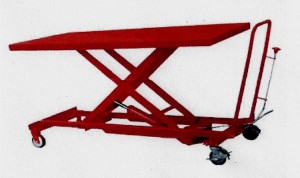
This table has a range of 12” to 35”. It is tested for 1100 lbs. It has a table size of 63” by 32”, making it ideal for locomotives. There is adequate space on both sides of the table for parts and tools. I used it to construct my GP7.
Unfortunately, these tables need some minor additions and modifications for maximum usage. A simple track made from 1” square tubing, ¾” square tubing, and some scrap 3/16” plate can be bolted to the table.
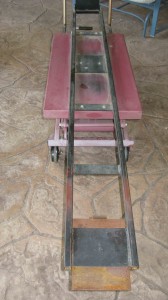
I made my track 7’ long with a 7 5/8” separation between the 1” square rails. This allows an overhang sufficient to provide clearance to truck bolsters at each end. Adding a sliding steel plate at one end is helpful for aligning the table with a vehicle carrier.
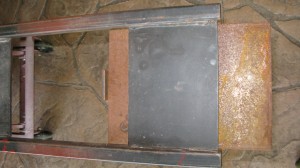
Telescoping a piece of ¾” tubing inside a 1” leg also allows alignment with another 1” rail. I also attached a stop at the handle end.
The load is of course best balanced so placing the rail correctly on the table is important. This will cause the need to extend the push/pull handle away from the table to clear the track. These welded extensions should be adequate in strength so the car or locomotive can be tied off to the handle. I use a large bungee cord or tie down belt connected to the coupler.
I have been using these tables for 5 1/2 years and have found them to be very much worth their cost. I have used them to detail & build a number of cars, build a GP7, rework trucks on an NW2, and display cars and locomotives at conventions.
| Advantages | Disadvantages |
| This design provides a built-in weight limit | Tables are heavy and take two people to load and move |
| Adjustable height design | Cost is higher than hand made tables |
| Easy fit and lock to the height of different carriers | Table reduces the access to the center/bottom of the car or locomotive |
| Built for high usage | |
| Built-in wheel stops |

